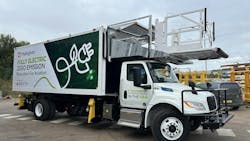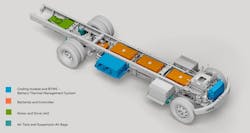Delta Air Lines’ biggest EV is an International truck
Delta Air Lines’ sustainability goals are grounded.
International eMV specs
GVWR: 25,999 and 33,000
Class: Class 6 or 7
Cab configuration: Day cab
Axle configuration: 4x2
Wheelbase options: 217-in., 236-in., 254-in., 272-in.
Battery system: 210 kWh lithium iron phosphate batteries
Operating voltage: 609V
Motor: Direct drive electric
Torque: 730 to 1737 lb.-ft.
Horsepower: 255 hp/190 kW
Vehicle applications: Dry van, reefer, utility, construction dump, landscape
Zero-emission airplanes are in development but don’t expect them to replace passenger jets soon. So Delta started its fleet electrification journey with a truck.
Next time you’re flying out of Boston Logan International Airport, your in-flight meal might be delivered to the aircraft galley by an International eMV. Working with International Motors and airport ground support upfitter Mallaghan, Delta’s EV catering truck started operating in January. It’s the first of its kind in North America, according to International.
Airport ground operations are prime for early electrification successes, thanks to the need for low-speed movements and constant stopping and “idling”—something that is harsh on diesel engines and nonexistent in EVs.
Helen Farr, Delta’s ground service equipment fleet strategy manager, said the airline has focused on ground support sustainability for several years. However, its focus has been on equipment smaller than the medium-duty eMV, which can be spec’d as a Class 6 or 7 truck.
The challenge of electrifying airport ground support
Those smaller, low-voltage fleet vehicle groups include baggage tractors, belt loaders, and push-back tractors. “The primary reason we’ve been focused on those fleets instead of others is they were commercially available and operationally feasible,” Farr said during a Green Truck Summit panel during NTEA’s Work Truck Week 2025 in Indianapolis on March 4.
Delta Air Lines sustainability goals
Like many major corporations, Delta Air Lines aims to achieve net-zero carbon emissions by 2050. However, air travel might be among the most challenging industries to decarbonize.
While Delta and others are developing sustainable aviation fuel to reduce emissions, its early focus is on enhancing operation efficiency and ground support. In advance of its centennial celebration in 2025, the airline highlighted several environmental initiatives last year as it made progress on its goals.
“For the longest time, we’ve been looking for chassis manufacturers and OEMs who could bring us sort of that midsized, large-sized truck that could sustain our operations,” she said. “We’re running typically three shifts at any large station, so being able to support and operate for that duration has been a somewhat difficult challenge.”
International and Mallaghan were up for the challenge.
“It sounded very promising up front from the duty cycle perspective—low speed, low miles,” Curt Studebaker, International product strategy director, said. “But we knew it was going to be a challenge. There was no clear solution at the outset.”
Through two years of technical meetings with Mallaghan and Delta to develop route data, range analysis, charging and dispatch strategies, they were able to seize the opportunity.
While electrifying the vast trucking industry is challenging because of range anxiety, some segments make much more sense.
“If you’re driving 100-plus miles a day, carrying a lot of weight, at very high speeds, every one of those attributes work against electrification,” noted Mallaghan CCO Joe Griffith. “But in our space, in our application and technology in aviation, it’s low speed. It’s short drive cycles. It’s a lot of sitting and waiting on airplanes to come in. So it really is a very good application of EV technology as it sits today.”
But that doesn’t mean it was an easy path to building North America’s first electric airline catering truck. “I think we have to take a step back and appreciate this was an engineering project,” Griffith said. “This took the engineering capabilities of International, Mallaghan, and Delta working together.”
Along with mapping out routing and energy capacity, the engineers had to provide refrigeration on the truck, which Griffith said was an added challenge.
See also: How to build a fleet future during times of uncertainty
Getting fleet crew buy-in
Delta’s Farr said the partnerships and engineering with International and Mallaghan were critical in its early fleet electrification success. But she also had to work with her ground fleet crew to get them invested in the journey.
“Anytime you bring anything new into operation, the operation is going to look at it a little sideways,” she said. “They’re going to say, ‘What’s this and why do I have this?’ You really have to manage the expectations and preliminarily prepare them for what’s coming their way. Otherwise, the change is going to be difficult.”
The OEM and upfitter helped Delta train its ground support staff on the eMV, including making the truck’s controls similar to the diesel-powered trucks they were used to and alleviating any range fears.
“You definitely want to make sure that anytime you’re introducing new equipment into your operation that you have a partner that’s going to stand by you from the beginning concept all the way to deployment and throughout servicing,” Farr added.
Debbie Shust, International VP of customer insights and experience, noted that the zero-emission journey has changed how OEMs like hers look at how fleets procure vehicles. Unlike traditional trucks, where dealers can simply hand over the keys to a fleet without knowing the specific details of the operation, this is not the case with EVs.
“We kind of had to know—but we didn’t really have to know,” Shust, who moderated the Green Truck Summit panel, said. “Now we want to ask questions about how much power you need. What’s the energy draw going to look like? Things that we never asked before. And sometimes our body builders and customers can’t answer for us because they didn’t need to know either.”
While diesel distance calculations are easier to understand, EV customers and OEMs are finding more success if they take the time to calculate range and load capabilities.
“It’s a lot easier for the OEMs to be able to deliver what we need when they have a deeper understanding of our operation, of our critical pain points, and things that make operations more efficient,” Farr said. “It makes us think about how we actually do our operations, to see if there are efficiencies that we are not doing simply because we had never thought about them before.”
About the Author
Josh Fisher
Editor-in-Chief
Editor-in-Chief Josh Fisher has been with FleetOwner since 2017. He covers everything from modern fleet management to operational efficiency, artificial intelligence, autonomous trucking, alternative fuels and powertrains, regulations, and emerging transportation technology. Based in Maryland, he writes the Lane Shift Ahead column about the changing North American transportation landscape.



